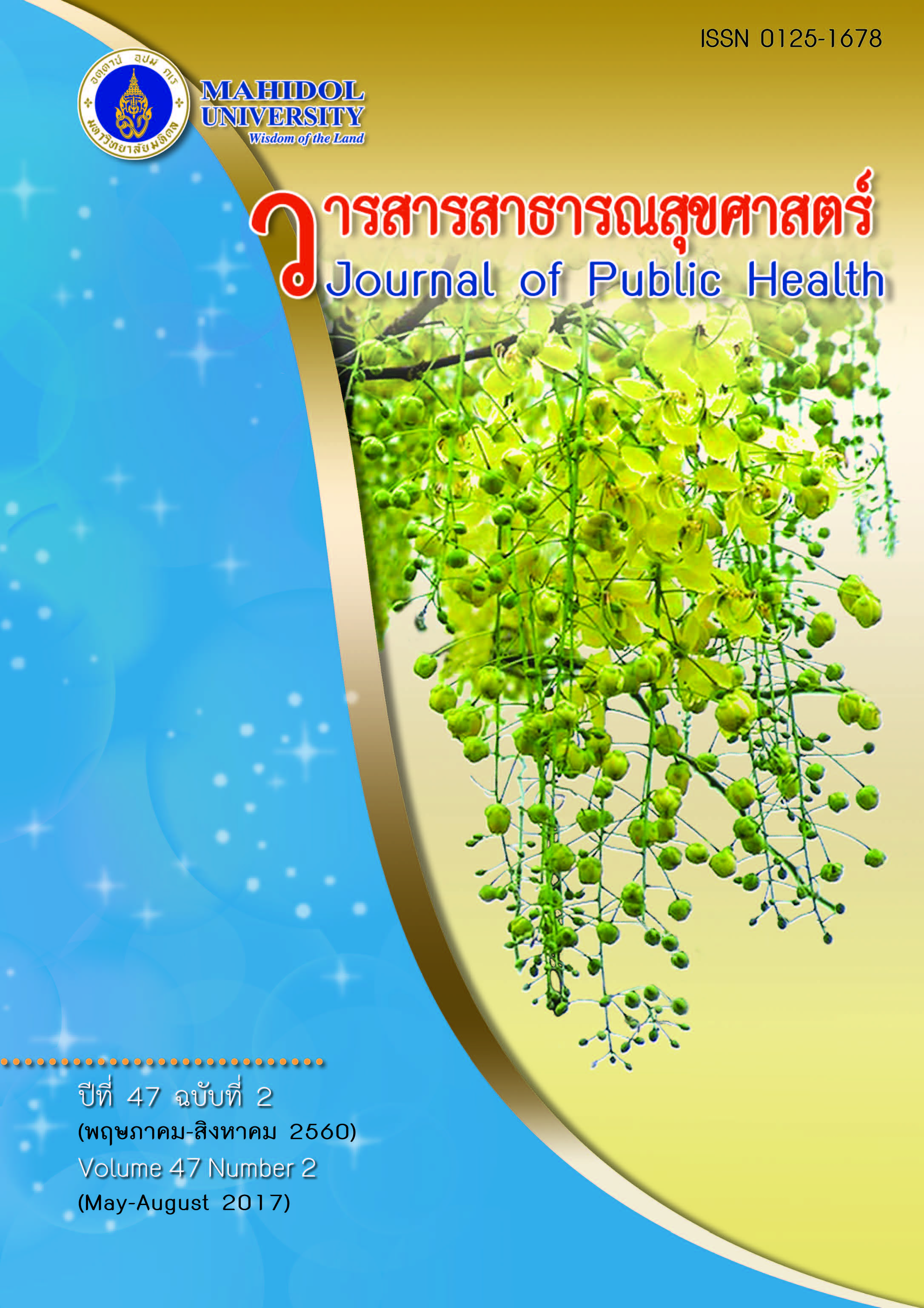การทำนายจำนวนผู้เสียชีวิตจากโรคหัวใจขาดเลือดในประเทศไทยด้วยตัวแบบเกรย์
Keywords:
การพยากรณ์, ตัวแบบเกรย์, โรคหัวใจขาดเลือด, อนุกรมเวลา, forecasting, grey system theory, ischemic heart disease, time seriesAbstract
ประเทศไทยมีผู้เสียชีวิตจากโรคหัวใจขาดเลือดในปี พ.ศ. 2558 ถึง 19,417 คน โดยเพิ่มขึ้น เฉลี่ยร้อยละ 10.679 ต่อปี จากปี พ.ศ. 2539 การทำนายล่วงหน้าที่แม่นยำจะนำไปสู่การวางแผนมาตรการด้านสาธารณสุขที่เหมาะสม การวิจัยนี้ได้นำตัวแบบเกรย์ซึ่งได้เริ่มมีการนำมาใช้ในการพยากรณ์อนุกรมเวลาในประเทศไทย โดยได้นำตัวแบบเกรย์พื้นฐาน (GM(1,1)) และตัวแบบปรับแก้ความคลาดเคลื่อน (GM(1,1)er) มาใช้กับข้อมูลผู้เสียชีวิตจากโรคหัวใจขาดเลือดในอดีต 5 ปี 10 ปี 15 ปี 20 ปี ที่มีรูปแบบแตกต่างกัน พบว่า GM(1,1) ให้ค่าพยากรณ์แสดงค่าที่เพิ่มขึ้นอย่างต่อเนื่อง ขณะที่ GM(1,1)er จะให้ค่าพยากรณ์ที่มีการเพิ่มขึ้นและลดลงใกล้เคียงกับรูปแบบข้อมูลในอดีตได้ดีกว่า ในการพยากรณ์เทียบกับข้อมูลจริงในปี พ.ศ. 2558 ซึ่งจำนวนผู้เสียชีวิตกำลังเพิ่มขึ้นนั้น พบว่า เมื่อใช้ข้อมูล 5 ปีตัวแบบGM(1,1)er ให้ค่าแตกต่างไปจากค่าจริงน้อยที่สุด ขณะที่เกณฑ์ค่าเฉลี่ยร้อยละคลาดเคลื่อนร้อยละสัมบูรณ์ (MAPE) และค่าเฉลี่ยความคลาดเคลื่อนกำลังสองถอดสแคว์รูท (RMSE) สูงกว่าการใช้ช่วงข้อมูลและตัวแบบในกรณีอื่น สรุปผลการทำนายโดยใช้ข้อมูลในอดีตเพียงอย่างเดียวด้วยเกณฑ์ MAPE และ RMSE ต่ำสุดในการพยากรณ์จำนวนผู้เสียชีวิตสำหรับปี พ.ศ. 2559 การใช้ช่วงข้อมูลในอดีต 10 ปี (2549-2558) โดยตัวแบบ GM(1,1)er มีค่า MAPE ต่ำสุดร้อยละ 1.25 และ มีค่า RMSE ต่ำสุด 210.88 ให้ค่าพยากรณ์ปี พ.ศ. 2559 เท่ากับ 21,120 คน เพิ่มขึ้นจากปี พ.ศ. 2558 ที่มี 19,417 เพียงร้อยละ 8.77 ซึ่งความแม่นยำจะปรากฏเมื่อได้มีการเปรียบเทียบกับรายงานสถิติปี พ.ศ. 2559 ต่อไป
Predicting the Number of Deaths from Ischemic Heart Diseases in Thailand Using Grey System Theory
The number of deaths from Ischemic Heart Diseases (IHD) in Thailand reached 19,417 persons in 2015 which had been increasing on an average of 10.67% each year since 1996. The basic form of grey model GM(1,1) and expanded form of GM(1,1) with residual correction (GM(1,1)er) are applied with the different shapes of past data of 5, 10, 15 and 20 years, GM(1,1) shows the predicted line in an average increase while the predicted line of GM(1,1)er is very close to the pattern of the real data. In forecasting for the year 2015 to verify the accuracy against the real value, the minimum error comes from GM(1,1)er with a data period of 5 years (2010-2014), while their mean average percentage error (MAPE) and root mean square error (RMSE) were still higher than other data periods. For 2016, when the minimum of MAPE and RMSE are used as the criteria, GM(1,1)er of a 10-year data period ( 1996-2015) had a minimum MAPE at 1.25% and minimum RMSE at 210.88, the predicted value for 2016 was 21,120 person (increased from 2015 at 8.77%).The accuracy of the Grey model will be realized after comparing the predicted value for 2016 with Health Statistics B.E. 2559.
Downloads
Published
Issue
Section
License
Creative Commons License CC-BY-ND


